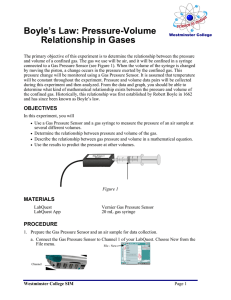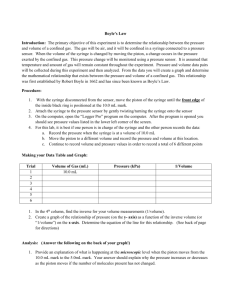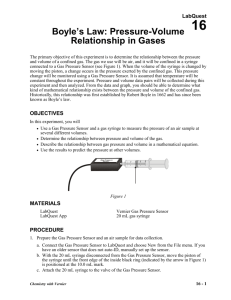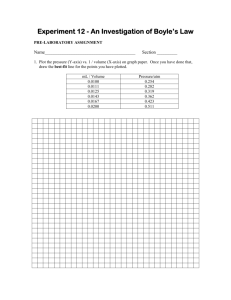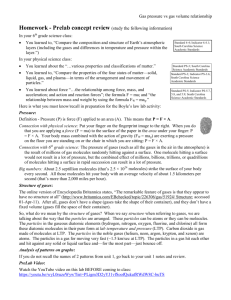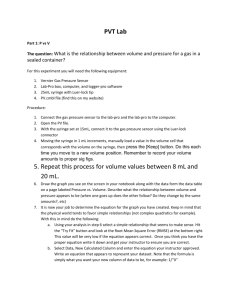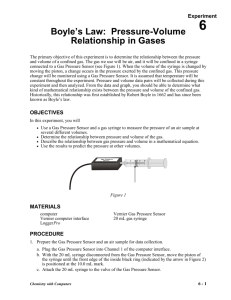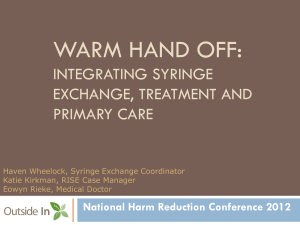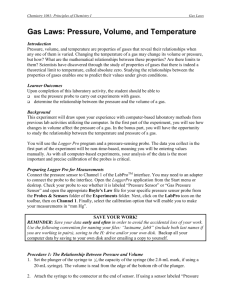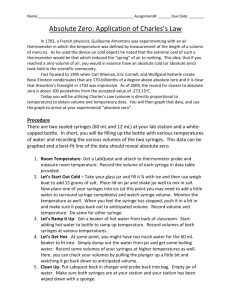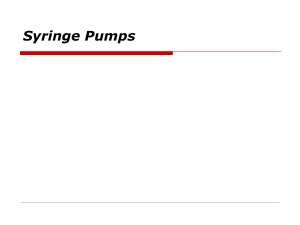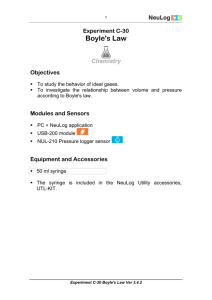Boyle*s Law: Pressure-Volume Relationship in Gases
advertisement
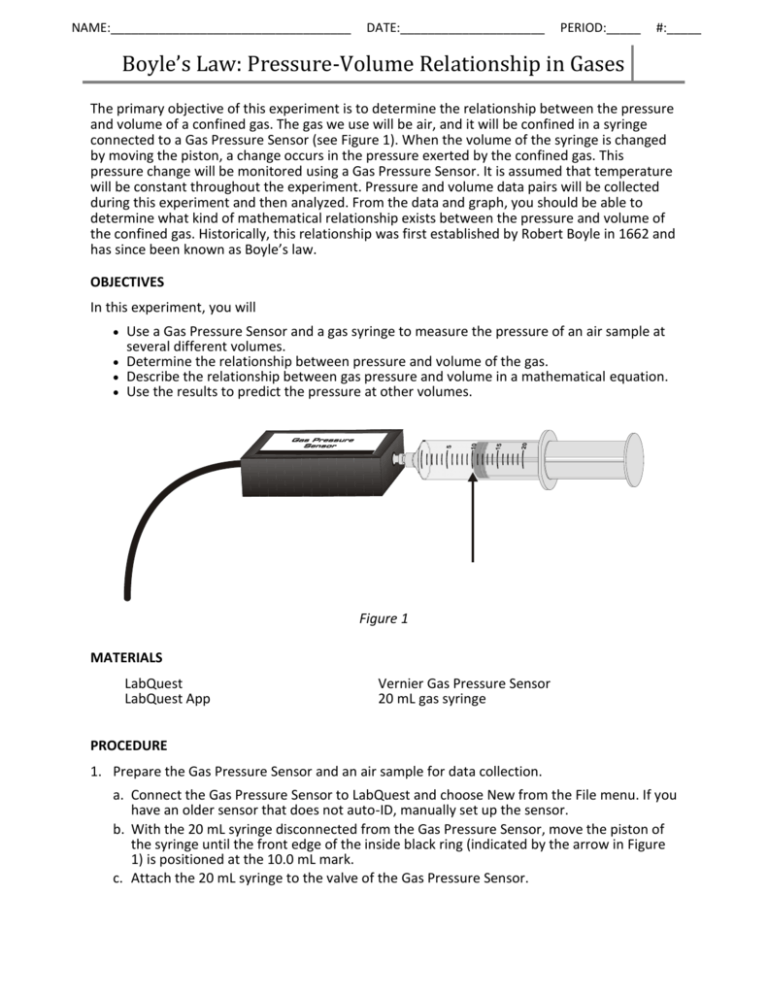
NAME:___________________________________ DATE:_____________________ PERIOD:_____ #:_____ Boyle’s Law: Pressure-Volume Relationship in Gases The primary objective of this experiment is to determine the relationship between the pressure and volume of a confined gas. The gas we use will be air, and it will be confined in a syringe connected to a Gas Pressure Sensor (see Figure 1). When the volume of the syringe is changed by moving the piston, a change occurs in the pressure exerted by the confined gas. This pressure change will be monitored using a Gas Pressure Sensor. It is assumed that temperature will be constant throughout the experiment. Pressure and volume data pairs will be collected during this experiment and then analyzed. From the data and graph, you should be able to determine what kind of mathematical relationship exists between the pressure and volume of the confined gas. Historically, this relationship was first established by Robert Boyle in 1662 and has since been known as Boyle’s law. OBJECTIVES In this experiment, you will Use a Gas Pressure Sensor and a gas syringe to measure the pressure of an air sample at several different volumes. Determine the relationship between pressure and volume of the gas. Describe the relationship between gas pressure and volume in a mathematical equation. Use the results to predict the pressure at other volumes. Figure 1 MATERIALS LabQuest LabQuest App Vernier Gas Pressure Sensor 20 mL gas syringe PROCEDURE 1. Prepare the Gas Pressure Sensor and an air sample for data collection. a. Connect the Gas Pressure Sensor to LabQuest and choose New from the File menu. If you have an older sensor that does not auto-ID, manually set up the sensor. b. With the 20 mL syringe disconnected from the Gas Pressure Sensor, move the piston of the syringe until the front edge of the inside black ring (indicated by the arrow in Figure 1) is positioned at the 10.0 mL mark. c. Attach the 20 mL syringe to the valve of the Gas Pressure Sensor. Boyle’s Law: Pressure-Volume Relationship in Gases 2. Set up the data-collection mode. a. On the Meter screen, tap Mode. Change the mode to Events with Entry. b. Enter the Name (Volume) and Units (mL). Select OK. 3. To obtain the best data possible, you will need to correct the volume readings from the syringe. Look at the syringe; its scale reports its own internal volume. However, that volume is not the total volume of trapped air in your system since there is a little bit of space inside the pressure sensor. To account for the extra volume in the system, you will need to add 0.8 mL to your syringe readings. For example, with a 5.0 mL syringe volume, the total volume would be 5.8 mL. It is this total volume that you will need for the analysis. 4. You are now ready to collect pressure and volume data. It is easiest if one person takes care of the gas syringe and another enters volumes. a. Start data collection. b. Move the piston so the front edge of the inside black ring (see Figure 2) is positioned at the 5.0 mL line on the syringe. Hold the piston firmly in this position until the pressure value displayed on the screen stabilizes. c. Tap Keep and enter 5.8, the gas volume (in mL) on the screen. Remember, you are adding 0.8 mL to the volume of the syringe for the total volume. Select OK to store this pressure-volume data pair. Figure 2 d. Continue this procedure using syringe volumes of 10.0, 12.5, 15.0, 17.5, and 20.0 mL. e. Stop data collection. 5. When data collection is complete, a graph of pressure vs. volume will be displayed. To examine the data pairs on the displayed graph, tap any data point. As you tap each data point, the pressure and volume values are displayed to the right of the graph. Record the pressure and volume data values in your data table. 6. Based on the graph of pressure vs. volume, decide what kind of mathematical relationship exists between these two variables, direct or inverse. To see if you made the right choice: a. Choose Curve Fit from the Analyze menu. b. Select Power as the Fit Equation. The curve fit statistics for these two data columns are displayed for the equation in the form: y = Ax^B where x is volume, y is pressure, A is a proportionality constant, and B is the exponent of x (volume) in this equation. Note: The relationship between pressure and volume can be determined from the value and sign of the exponent, B. c. If you have correctly determined the mathematical relationship, the regression line should very nearly fit the points on the graph (that is, pass through or near the plotted points). d. Select OK. NAME:___________________________________ DATE:_____________________ PERIOD:_____ #:_____ Boyle’s Law: Pressure-Volume Relationship in Gases DATA AND CALCULATIONS 1. Fill in the volume and pressure columns using the data collected in the lab. 2. Complete the indicated calculations for the last two columns. Volume (mL) Pressure (kPa) P÷V AVG: P•V AVG: PROCESSING THE DATA 1. Using the printed graph supplied by your teacher, determine what happens to pressure if volume is halved from 20.0 to 10mL. Use specific data to support your answer. 2. Using the printed graph supplied by your teacher, determine what happens to pressure if volume tripled from 5.0 to 15.0mL. Use specific data to support your answer. 3. Sketch a graph of the pressure vs. volume relationship. Be sure to label axes with titles and units. 4. From your answers questions 1 and 2 and the shape of the curve in the plot of pressure vs. volume, do you think the relationship between the pressure and volume of a confined gas is direct or inverse? Explain your answer. Boyle’s Law: Pressure-Volume Relationship in Gases 5. One way to determine if a relationship is inverse or direct is to find a proportionality constant, k, from the data. If this relationship is direct, k = P/V. If it is inverse, k = P•V. Based on the information in your data table, and your answer to question 3, select the proper equation for the relationship between pressure and volume. 6. Write a verbal statement that correctly expresses Boyle’s law (the relationship between pressure and volume of gases). 7. Using the equation you selected in question 4, what would you expect the pressure to be if the volume of the syringe was increased to 40.0 mL? Show work to support your answer. 8. Using the equation you selected in question 4, what would you expect the pressure to be if the volume of the syringe was decreased to 2.5 mL? Show work to support your answer. 9. What environmental factor was assumed to be constant in this experiment? If this factor was not held constant, how might it affect the results? 10. Looking at your data table, which data point deviated most from the expected value? Make a prediction as to why this data point deviates the most.
